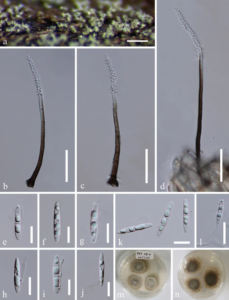Pseudodactylaria uniseptata J. Yang, E.B.G. Jones & K.D. Hyde, sp. nov.
Index Fungorum number: IF 559824; MycoBank number: MB 559824; Facesoffungi number: FoF 12835
Etymology – referring to the uniseptate conidia
Holotype – MFLU 22-0072
Saprobic on decaying submerged wood in freshwater. Asexual morph: Colonies on wood effuse, hairy, scattered or aggregated, brown, with glistening conidial masses at the apex. Mycelium partly superficial, partly immersed, composed of septate, smooth, pale brown to hyaline hyphae. Conidiophores macronematous, mononematous, erect, straight or slightly flexuous, cylindrical, smooth-walled, septate, unbranched, dark brown, paler to hyaline towards the apex, thick-walled, 90–185 × 3–4.8 µm (x̄ = 140 × 3.7 µm, n = 20). Conidiogenous cells polyblastic, integrated, rarely discrete, terminal, cylindrical, denticulate, hyaline, 2.4–3.7 µm wide, 27–50 µm long about 1/3 of the conidiophore. Conidia acrogenous, narrowly fusiform, uniseptate, smooth, guttulate, hyaline, 20–25 × 2.8–4 µm (x̄ = 22 × 3.3 µm, n = 40), thin-walled, usually with a hyaline, irregular appendage. Sexual morph: Undetermined.
Culture characteristics – Conidia germinating on PDA medium within 24 h. Germ tubes produced from both ends. Colonies on PDA medium reaching 10–15 mm diam. after 2 weeks at 25 °C in natural light, with dense mycelium on the surface, pale brown in the middle, white in the inner ring and pale brown in the outer ring; in reverse brown in the middle and paler at the entire margin.
Material examined – THAILAND, Trat Province, Amphoe Ko Chang, 12.133° N, 102.633° E, on decaying wood submerged in a freshwater stream, 27 April 2017, Y.Z. Lu, YJT29-2 (MFLU 22-0072, holotype; HKAS 112161, isotype), ex-type cultures MFLUCC 17-2395 and GZCC 20-0404.
Notes – Among Pseudodactylaria species, three new species, P. denticulata, P. longidenticulata and P. uniseptata, possess longer conidiophores (maximum length more than 100 µm) than that of the others (less than 100 µm) (Table 7). Pseudodactylaria denticulata, P. longidenticulata and P. uniseptata share similar morphology in having brown conidiophores, denticulate conidiogenous cells and hyaline, narrowly fusiform, uniseptate conidia, usually with hyaline irregular appendage. However, they can be distinguished by the dimensions of conidiophores, conidiogenous cells and conidia (Table 7). In the phylogenetic analysis (Fig. 53), Pseudodactylaria uniseptate was positioned as a sister taxon to P. longidenticulata.

Figure 1. Pseudodactylaria uniseptata(MFLU 22-0072, holotype). a Colony on wood. b–d Conidiophores with conidiogenous cells. e–k Conidia. l Germinated conidium. m, n Culture, m from above, n from below. Scale bars: a = 200 µm, b–d = 30 µm, l = 20 µm, e–k = 10 µm
